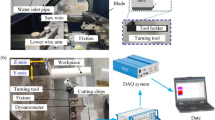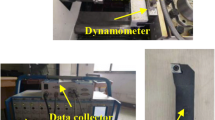Abstract
The influence of tool wear on cutting force in turning glass–ceramics was studied, and a theoretical model of turning force considering tool wear was established in this paper. Firstly, the crack propagation behavior and the form of energy dissipation were analyzed during chip formation, and the model of the force due to chip formation was established based on the fracture mechanics of brittle solids and the principle of energy transfer. Secondly, the mechanical model caused by the flank wear was established by analyzing the microscopic wear mechanism of the tool and the source of friction. Finally, the theoretical model of turning force considering the tool wear was established. The model is only applicable to brittle removal mode. Two different cutting tools were selected to carry out the experiment of turning fluorophlogopite glass–ceramics. The relationship between cutting force and tool wear was discussed, and the accuracy of the model was verified. The results showed that the tool wear has a direct impact on the cutting force, and the theoretical model of cutting force established is in good agreement with the experimental data in this paper.






















Similar content being viewed by others
Data availability
All data generated or analyzed during this study are included in this article. All participants state that the contents of the article do not contain unknown, fake or false data.
Code availability
Not applicable.
References
Ma LJ, Yu AB, Chen J (2017) Theoretical model of cutting force in turning the lithium disilicate glass-ceramic. Int J Adv Manuf Technol 92:4355–4366
Li C, Hu YX, Zhang FH, Geng YQ, Meng BB (2023) Molecular dynamics simulation of laser assisted grinding of GaN crystals. Int J Mech Sci 239:107856
Ma LJ, Li C, Chen J, Li W, Tan YQ, Wang C, Zhou YG (2017) Prediction model and simulation of cutting force in turning hard-brittle materials. Int J Adv Manuf Technol 91:165–174
Sun Y, Jin LY, Gong YD, Wen XL, Yin GQ, Wen Q, Tang BJ (2022) Experimental evaluation of surface generation and force time-varying characteristics of curvilinear grooved micro end mills fabricated by EDM. J Manuf Process 73:799–814
Razavi H, Nategh M, Abdullah A (2012) Analytical modeling and experimental investigation of ultrasonic-vibration assisted oblique turning, part II: dynamics analysis. Int J Mech Sci 63:12–25
Campocasso S, Costes J, Fromentin G, Bissey-Breton S, Poulachon G (2015) A generalised geometrical model of turning operations for cutting force modelling using edge discretisation. Appl Math Model 39:6612–6630
Dorlin T, Fromentin G, Costes J (2015) Analysis and modelling of the contact radius effect on the cutting forces in cylindrical and face turning of Ti6Al4V titanium alloy. Procedia CIRP 31:185–190
Joardar H, Das N, Sutradhar G, Singh S (2014) Application of response surface methodology for determining cutting force model in turning of LM6/SiCP metal matrix composite. Measurement 47:452–464
Розенберт АМ, Eремин АН (1956) Metal cutting theory. Mechanical architecture press of national science and technology department of Soviet Union, Soviet Union, Russian
Weng J, Zhuang KJ, Zhu DH, Guo SS, Ding H (2018) An analytical model for the prediction of force distribution of round insert considering edge effect and size effect. Int J Mech Sci 138–139:86–98
Wang Y, Yuan Z, Wu T, Yan H (2021) Prediction of cutting force in ultra-precision machining of nonferrous metals based on strain energy. Nanotechnol Precis Eng 4:43001
Liao Z, Axinte D (2016) On chip formation mechanism in orthogonal cutting of bone. Int J Mach Tools Manuf 102:41–55
Ma LJ, Sun ZC, Zhang L, Deng H, Tan Y, Kong Z, Wei Z (2020) Study on mechanism and theoretical model of tool wear in fluorophlogopite glass-ceramics turning. J Mater Process Technol 275:116284
Ma LJ, Cai CY, Tan YQ, Gong YD, Zhu LD (2019) Theoretical model of transverse and longitudinal surface roughness and study on brittle-ductile transition mechanism for turning Fluorophlogopite ceramic. Int J Mech Sci 150:715–726
Ma LJ, He P, Deng H, Liu T, Tan YQ, Zhou YG (2019) Theoretical model of characteristic temperature and continuous fracture mechanism of brittle material in the process of turning fluorophlogopite ceramics. Ceram Int 45:12521–12527
Ma LJ, Wang H, Yu AB, Wang LZ, Zhou YG (2017) Theoretical equation of cutting temperature for brittle materials in turning fluorophlogopite ceramics. Int J Adv Manuf Technol 92:3571–3582
Toubhans B, Fromentin G, Viprey F, Karaouni H, Dorlin T (2020) Machinability of inconel 718 during turning: cutting force model considering tool wear, influence on surface integrity. J Mater Process Technol 285:116809
Huang Y, Liang SY (2005) Modeling of cutting forces under hard turning conditions considering tool wear effect. J Manuf Sci Eng 127:262–270
Wang J, Huang CZ, Song WG (2003) The effect of tool flank wear on the orthogonal cutting process and its practical implications. J Mater Process Technol 142:338–346
Li C, Piao YC, Meng BB, Hu YX, Li LQ, Zhang FH (2022) Phase transition and plastic deformation mechanisms induced by self-rotating grinding of GaN single crystals. Int J Mach Tools Manuf 172:103827
Liu T, Ma LJ, Wang Y, Bai W, Chang H (2019) Removal mechanism of machinable ceramics and theoretical model of cutting force in turning operation. Mechl Sci 10:429–436
Anderson TL, Deng J (2005) Fracture mechanics: fundamentals and applications. Taylor & Francis Group, Boca Raton, USA
Lawn BR (1993) Fracture of brittle solids. Cambridge University Press, Cambridge
Erdogan F, Sih GC (1963) On the crack extension in plates under plane loading and transverse shear. J Basic Eng 85(4):519–527
Griffith AA (1921) The phenomena of rupture and flow in solids. Phil Trans Roy Soc Lon 221(582–593):163–197
Mott NF (1948) Brittle fracture in mild steel plates. Engineering 165:16–18
Lawn BR, Rodney W (1975) Indentation fracture: principles and applications. J Meter Sci 10:1049–1081
Roberts DK, Wells AA (1954) The velocity of brittle fracture. Engineering 178(4639):820–821
Bowden FP, Tabor D (2001) The friction and lubrication of solids. Oxford University Press, Oxford
Zhang W, Subhash G (2001) An elastic–plastic-cracking model for finite element analysis of indentation cracking in brittle materials. Int J Solids Struct 38:5893–5913
Funding
This work is supported by the National Natural Science Foundation of China (grant number 51975113). Such support is greatly appreciated by the authors.
Author information
Authors and Affiliations
Contributions
Hongshuang Li is the first author, who writes the manuscript and performs the experiment and the data analyses. Lianjie Ma is the corresponding author, who contributes to the conception of the study and supplies funding for this study. Liye Sun and Wenhao Du participated in the construction of experimental platform.
Corresponding author
Ethics declarations
Ethics approval
This paper does not contain any studies with human participants or animals performed by any of the authors.
Consent to participate
All of the authors consent to participate.
Consent for publication
All of the authors consent for publication.
Conflict of interest
The authors declare no competing interests.
Additional information
Publisher's note
Springer Nature remains neutral with regard to jurisdictional claims in published maps and institutional affiliations.
Rights and permissions
Springer Nature or its licensor (e.g. a society or other partner) holds exclusive rights to this article under a publishing agreement with the author(s) or other rightsholder(s); author self-archiving of the accepted manuscript version of this article is solely governed by the terms of such publishing agreement and applicable law.
About this article
Cite this article
Li, H., Ma, L., Sun, L. et al. A cutting force theoretical model under the wear effect in turning glass–ceramics. Int J Adv Manuf Technol 125, 5295–5311 (2023). https://doi.org/10.1007/s00170-023-10829-z
Received:
Accepted:
Published:
Issue Date:
DOI: https://doi.org/10.1007/s00170-023-10829-z




